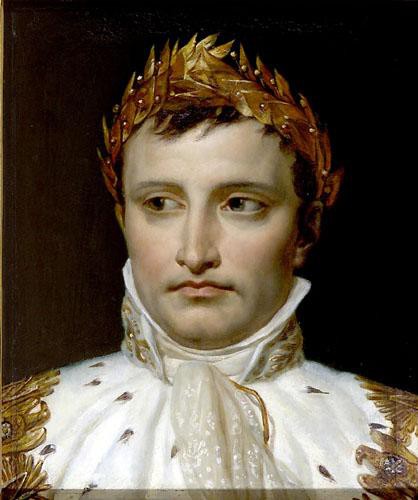The story behind this painting has for a long time intrigued historians of the painter Jacques Louis David. The portrait should be considered in reference to a painting of the Emperor in his imperial robes that David was commissioned to paint in 1805. The painting was destined to hang in the large law courts in Genoa (Italy) and was commissioned by Lebrun, then arch-treasurer, who was preparing for the union of the former Republic of Genoa with the French Empire. Napoleon agreed to the commission in August 1805 and David immediately produced a rough draft (sketch signed and dated August 1805, Musée des Beaux-Arts de Lille). He set to work, and the canvas, which is more than 2.8m tall, was completed in 1806 and presented to the Emperor at Saint-Cloud in July of that year. Napoleon rejected it, announcing emphatically in a letter to Daru: “I have just seen the portrait of me produced by David. It is a portrait so awful, so full of defects that I cannot accept it: I shall not have it hanging in any town, especially not in Italy where it would present a poor impression of our school.” At the time, David's enemies spread the rumour that he had left the actual execution of the painting to Devilliers, one of his students, and that it suffered due to this.
Following the Emperor's harsh critique of the painting, the artist went back to the drawing board, producing a second painting in 1807. Once again, Napoleon rejected it (sketch signed and dated 1807, Cambridge, Fogg Art Museum, U.S.A.). It is the head of the second version that appears in the Fondation Dosne-Thiers example seen here. Infuriated, Napoleon ended up cancelling the commission's funding. David would never finish his official portrait of the Emperor. In 1811, he was privatedly commission by Alexander Douglas to produce a portrait of Napoleon in his study at the Tuileries. The painting was to hang in Douglas' residence, Hamilton Castle, in Scotland (Washington, National Gallery of Art). The following year, the painter began work on a copy of the Douglas painting, but it remained in his workshop and was only obtained by Napoleon III during the Second Empire (Musées nationaux, subject to the owner's right to usufruct).
The Fondation Dosne-Thiers painting shows Napoleon wearing the famous laurel-wreath crown, produced by Biennais and made up of forty-four large leaves, forty-two detachable berries and twelve smaller leaves, set on an oval band and fixed at the back of the head by a pin. This crown was destroyed during the Restoration. Only one leaf survives, which was given to Isabey, who had it mounted in a snuff-box which bears the following inscription: “At Saint-Cloud in 1805, before the departure for Milan, I was helping the emperor as he tried on the royal crown which was supposed to go above the golden laurel wreath made for the coronation in Notre-Dame. One of the leaves fell off. Just as I was about to give it to the head chamberlain, His Majesty said to me: 'Keep it; it will make a good souvenir of your clumsiness.'” (Musée de Fontainebleau).
Bernard Chevallier (tr. H.D.W.)
Conservateur général honoraire du patrimoine
The text is an extract from the catalogue accompanying the exhibition “Splendeurs de l'Empire. Autour de Napoléon et de la cour impériale”.
This painting formed part of the “Napoleon: Revolution to Empire” exhibition, on display at the National Gallery of Victoria, Melbourne, Australia, from 2 June 2012 to 7 October 2012.
July 2009
Napoleon and crown
Artist(s) : DAVID Jacques-Louis

- Date :
- 1807 (?)
- Technique :
- Oil on wood
- Dimensions :
- H = 43.5 cm, L = 36.1 cm
- Place held :
- Paris, Fondation Dosne-Thiers (Institut de France)
- Photo credit :
- © Art go

